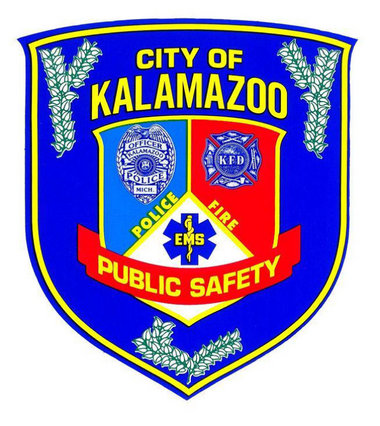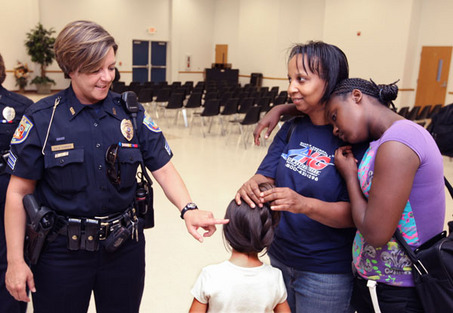Kalamazoo, Michigan: Using Community Policing to Create a “Wow” Department

The Kalamazoo Department of Public Safety (KDPS) focuses on reducing crime; building and maintaining trust; and providing the most efficient, effective, and professional public safety services possible.1 These goals are accomplished by focusing on six key areas: (1) enforcement and investigation of criminal activity; (2) blight reduction in targeted neighborhoods to improve quality of life; (3) ongoing training of department personnel; (4) community interaction; (5) internal process review, updating, and development; and (6) developing and maintaining strong community partnerships.2 The mission and these key areas have driven the department to work to close the gap between police and the community. Relationship building became even more important after the release of a critical report on racial profiling by the department.
Impetus for change
In 2011, with an increase in awareness of and concern over the treatment of minority motorists by police, the KDPS voluntarily requested a study into traffic stop data.3 Looking at data in 12 locations from March 1, 2012 to February 28, 2013, Black motorists were stopped at a higher rate than non-Black motorists.4 The weighted average for all 12 locations was that a Black motorist was 2.32 times more likely to be stopped than a non-Black motorist.5 Coupled with more stops, Black motorists were handcuffed and arrested more often but were also least likely to be found carrying contraband.6 The report was released in September 2013, and although the community took the results well, the release prompted KDPS Chief Jeff Hadley to reevaluate the department’s strategy and approach to public safety.
Organizational transformation
With the release of the report, Hadley had the opportunity to meet with all the officers and explain that the department had to get back to the basics. Taking a note from various customer-oriented businesses like Disney and Lexus, KDPS needed to evolve into a focus on service, service being the department’s product. By changing the focus to service, the department was able to swing the pendulum of services from a focus on number of arrests and traffic stops “to reduc[ing] crime by providing ‘wow’ service every chance we get.”7 In large part, the idea for the vernacular “wow” service and modeling after corporate America came from Captain James Mallery. This concept also included our intent to change the department’s internal reward system from a statistic-driven to a customer service one.
The adoption of new policies and procedures such as a “consent-to-search” policy was developed with help from Chief Art Acevedo from the Austin (Texas) Police Department and Chief Ed Flynn from the Milwaukee (Wisconsin) Police Department.8 Training was increased and expanded to include implicit bias training such as Dr. Lorie Fridell’s Fair and Impartial Policing.9 The transformation involved bringing back the focus to working with the community, being genuinely concerned, following up with victims, building trust, and solving crime.10 In addition, every shift, training, and interaction with the public had an interwoven emphasis on respect.
Although community members were able to report complaints online, the KDPS developed a reward system for positive feedback or “wow” service.11 This change in the department and an emphasis on service has brought to light some positive stories and comments from the public.
Beyond policing
 At the end 2013, a national bus service dropped 20 passengers off at the local bus terminal late at night. The driver told the passengers to wait outside until the bus terminal reopened several hours later. Dispatched KDPS officers arrived at the bus terminal and, after learning about the situation, coordinated meals for the waiting passengers and shelter via city buses. After hearing that two of the passengers were in transit to visit their sick grandmother, an officer was authorized to drive them an hour and a half to Ann Arbor. Once the terminal opened, the passengers thanked the officers by giving them a standing ovation. The officers later received commendations in their files and City All Star awards.
At the end 2013, a national bus service dropped 20 passengers off at the local bus terminal late at night. The driver told the passengers to wait outside until the bus terminal reopened several hours later. Dispatched KDPS officers arrived at the bus terminal and, after learning about the situation, coordinated meals for the waiting passengers and shelter via city buses. After hearing that two of the passengers were in transit to visit their sick grandmother, an officer was authorized to drive them an hour and a half to Ann Arbor. Once the terminal opened, the passengers thanked the officers by giving them a standing ovation. The officers later received commendations in their files and City All Star awards.
In December 2014, a would-be burglar kicked in the front door of a house, setting off the alarm. KDPS officers arrived, processed the scene, and began the investigation. After the officers were done with the scene, three uniformed officers stayed behind to help fix the frame and rehang the door. The son-in-law of the owners, who was watching the house at the time, said that the officers “. . . did an awesome job. We thanked them for it. And it should be noted . . . it wasn’t required for them to do any of that. They’re not carpenters. . . . They didn’t leave until the house was back secure . . . they didn’t have to do that. That’s not their job. That, to me, is going beyond [the call of] duty.”12
Story after story of the officers going beyond the call of duty continue to impress Mallery. “I am proud of the front-line officers and sergeants who have embraced this initiative and performed above and beyond my expectations. They continually amaze me with the ‘wow’ service that they provide the citizens we serve. The stories are incredible.” These two moments are just few of the many positive encounters that are encouraged and respected by both the KDPS leadership and the community. This type of respect is being instilled in the officers, creating a legitimate department for the community. In turn, the relationship between the community and police is strengthening and the community is experiencing procedural justice.13
Deadly Encounter
In October 2014, this relationship and respect was tested.
Police Officer Rick McCall had several run-ins over the years with a particular violent suspect. McCall had arrested this suspect three times. At the end of October 2014, the suspect had an outstanding arrest warrant and, when McCall saw him, he pursued him on foot. The suspect jumped over a five-foot chain link fence, tripping in the process, and, as he fell, a gun fell out of his pants upon impact. McCall jumped after him and got caught on the fence by his belt. McCall was hanging about four feet off the ground while holding the suspect’s arm. McCall, seeing the gun, shouted “No,” but the suspect said, “McCall, I wouldn’t do that to you,” and he—the suspect—pushed his own gun away.
While McCall untangled himself from the fence, the suspect cooperated. The suspect did not resist arrest. McCall was walking the suspect back to his the patrol car and asked him, “Would you have shot me?” The suspect replied, “No McCall, you have always treated me decently.” McCall’s choice to treat the suspect with respect and dignity through their numerous interactions, even when arresting him, saved his life that day. A true story of procedural justice.
Building relationships with the community as a whole
 Hadley and the rest of the KDPS wanted to go beyond respectful interactions with people who traditionally encounter the police, so they set a goal of canvassing the entire city in one year. Every shift, two sergeants went door to door in a two-block area asking residents how things were going and completing a citizen satisfaction survey. Every week, the two-block area moved, allowing the department to meet the goal of at least one in-person interaction every year with the entire community. Sergeants also provide specific details to the residents about a specific incident or crime that recently occurred. This process provides the community members the opportunity to interact with the police in a casual and in person situation. In addition, following on the broken windows theory, officers have begun picking up trash and cleaning up neighborhoods.14 Working with probationers, the officers are beautifying the neighborhoods while informally mentoring.15
Hadley and the rest of the KDPS wanted to go beyond respectful interactions with people who traditionally encounter the police, so they set a goal of canvassing the entire city in one year. Every shift, two sergeants went door to door in a two-block area asking residents how things were going and completing a citizen satisfaction survey. Every week, the two-block area moved, allowing the department to meet the goal of at least one in-person interaction every year with the entire community. Sergeants also provide specific details to the residents about a specific incident or crime that recently occurred. This process provides the community members the opportunity to interact with the police in a casual and in person situation. In addition, following on the broken windows theory, officers have begun picking up trash and cleaning up neighborhoods.14 Working with probationers, the officers are beautifying the neighborhoods while informally mentoring.15
Finally, the chief challenged each officer to spend at least 20 minutes per shift on community engagement and “wow” service. As Hadley says, “It is all about relationships, and by incorporating patrol in the total philosophy of community engagement and not designating it to one unit or division, more substantial progress can be made. The officers in the neighborhoods are the force multiplier!”
With the changes that the KDPS has undergone over the last several years, it’s no wonder that they are receiving national recognition. The Vistelar Group, an organization focused on human conflict, recently awarded the KDPS with the Community Partnership award “for outstanding community relations, customer oriented service, and nontraditional engaged problem solving.”16 Community partnerships, problem solving, organizational transformation, and procedural justice—all important pieces of community policing.
Written with contributions from Kalamazoo Department of Public Safety Chief Jeff Hadley and Captain James Mallery.
Nazmia E.A. Comrie
Editor-in-Chief and Senior Social Science Analyst
The COPS Office
References
1 City of Kalamazoo, “About KDPS,” City of Kalamazoo Department of Public Safety, accessed May 26, 2015, http://kalamazoopublicsafety.org/inside-kdps/about-kdps. 2 Ibid.3 John C. Lamberth, Traffic Stop Data Analysis Project, City of Kalamazoo Department of Public Safety (West Chester, PA: Lamberth Consulting, 2013), http://mediad.publicbroadcasting.net/p/michigan/files/201309/KDPS_Racial_Profiling_Study.pdf.
4 Ibid.
5 Ibid.
6 Ibid.
7 Interview with Chief Hadley and Captain Jim Mallery, KDPS, January 20, 2015..
8 Critical Issues in Policing Series: Defining Moments for Police Chiefs (Washington, DC: Police Executive Research Forum, 2015), http://www.policeforum.org/assets/definingmoments.pdf.
9 Ibid.
10 Chris Killian, “Kalamazoo’s Police ‘Trust Gap’ Part 1,” WMUK, last modified October 10, 2014, http://wmuk.org/post/kalamazoos-police-trust-gap-part-1.
11 City of Kalamazoo, “Positive Feedback,” City of Kalamazoo Department of Public Safety, accessed May 26, 2015, http://kalamazoopublicsafety.org/get-involved/positive-feedback.
12 Al Jones, “Kalamazoo Fit-it Cops Stay after Break-in to Repair Door, Secure Home,” MLIVE, last modified December 23, 2014, http://www.mlive.com/news/kalamazoo/index.ssf/2014/12/kalamazoo_fix-it_cops_may_help.html.
13 See Charlene Moe and Melissa Bradley, “Organizational Change through Decision Making and Policy: A New Procedural Justice Course for Managers and Supervisors,” Dispatch 8, no. 4 (April 2015), http://cops.usdoj.gov/html/dispatch/04-2015/a_new_procedural_justice_course.asp for a discussion on the pillars of procedural justice.
14 “KDPS officers engage in clean-up operation on Kzoo’s north side,” WWMT, last modified August 28, 2014, http://www.wwmt.com/news/features/top-stories/stories/KDPS-officers-engage-in-clean-up-operation-on-Kzoo-39-s-north-side-28234.shtml.
15 Ibid.
16 James Mallery, “Community Partnership Award,” Kalamazoo Public Safety news release, December 2, 2014, http://www.kalamazoopublicsafety.org/service/30-kdps-blog/kdps-news/673.
July Photo Contest Winner | Kalamazoo and Community Policing | President's Task Force | National Police Week 2015 | Education Opportunity
